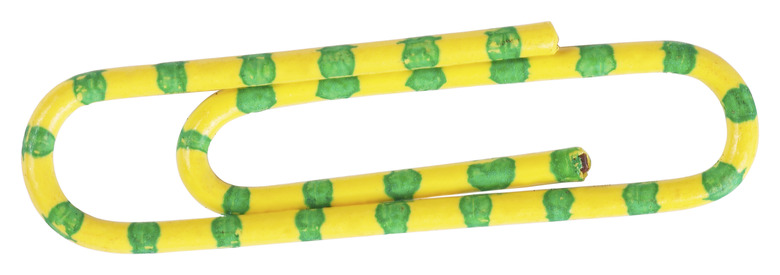How To Demonstrate Surface Tension With A Paperclip And Water For A Science Experiment
The surface tension of water describes how molecules on the surface of the liquid attract each other. The surface tension of water allows objects of greater density to be supported on the surface of the water. The attraction of a molecule to itself is called cohesion, and attraction between two different molecules is called adhesion. The paperclip floating on the surface of water demonstrates to your children how the surface tension of water works. Indeed, surface tension is what allows small insects to walk on the surface of water — or what allows dust and leaves to float on the surface of water. This property, in conjunction with cohesion, is what allows the surface portion of a liquid to form drops, such as water drops.
Step 1
Fill a bowl, glass or beaker with water.
Step 2
Float a small piece of paper towel on the surface of the water.
Step 3
Place the paperclip on top of the paper towel.
Step 4
Push the sides of the paper towel carefully down into the water until the paper towel is no longer touching the paperclip.
Step 5
Remove the paper towel carefully from the water. The paperclip should easily remain floating on the surface of the water unless it is disturbed or bumped.
Step 6
Mix some soap with water in a container.
Step 7
Add a couple drops of soapy water to the surface of the water using a dropper. Do this where the paperclip is floating. But be careful to add it to the water away from the paperclip. The soapy water should break the surface tension of the water, causing the paperclip to fall to the bottom of the container. If it doesn't work immediately, give it a few seconds or add a few more drops of soapy water.
Step 8
Ask your child or student to explain why the paperclip floats on water (since it is denser than water). This is also a way to help your young children become or stay interested in science.
Step 9
Ask your children or students why they think soapy water caused the paperclip to fall to the bottom. (Hint: It is because soap is a surfactant, and that reduces the surface tension of water.)
Things Needed
- Bowl, glass or beaker
- Paper towel
- Metal paperclip
- Soapy water
- Dropper
TL;DR (Too Long; Didn't Read)
Water beading on a freshly waxed car forms a sphere because of the water's surface tension.
The separation of oil and water is caused by several different properties of the liquids, including the differences in the surface tension of the liquids — called "interface tension."
References
Cite This Article
MLA
Contributor, . "How To Demonstrate Surface Tension With A Paperclip And Water For A Science Experiment" sciencing.com, https://www.sciencing.com/demonstrate-water-great-science-experiment-5559840/. 24 April 2017.
APA
Contributor, . (2017, April 24). How To Demonstrate Surface Tension With A Paperclip And Water For A Science Experiment. sciencing.com. Retrieved from https://www.sciencing.com/demonstrate-water-great-science-experiment-5559840/
Chicago
Contributor, . How To Demonstrate Surface Tension With A Paperclip And Water For A Science Experiment last modified August 30, 2022. https://www.sciencing.com/demonstrate-water-great-science-experiment-5559840/
